A VIGNERON, A VINE AND THREE PLANETS WALK INTO A BAR…
A VIGNERON, A VINE AND THREE PLANETS WALK INTO A BAR… The Vigneron says to the Vine, “show me how you flower.”
2023
TRIPPIN’ ROUND THE SUN
Second time around. If we wore belts we’d have no problem pointing out that there was something under them. We were excited, optimistic and hoping that whatever it is that’s under those figurative belts of ours can be of some use.
 Pruning vines, pruning vibes. Pruning is a beautiful and intimate activity. Winter signifies an inward sensitivity to all; the soil and plant roots truly become receptive. If – as should be standard viticultural practice – you intend on talking to your soil and vines – providing kind words of encouragement and cohesion – then winter pruning is the time for talking. The incessant buzz of summer has died down, everything has taken a deep breath inward, and all ears are clear for the hearing.
Pruning vines, pruning vibes. Pruning is a beautiful and intimate activity. Winter signifies an inward sensitivity to all; the soil and plant roots truly become receptive. If – as should be standard viticultural practice – you intend on talking to your soil and vines – providing kind words of encouragement and cohesion – then winter pruning is the time for talking. The incessant buzz of summer has died down, everything has taken a deep breath inward, and all ears are clear for the hearing.

Late frosts, again. The first frost event in October took victim of the early emerging Chardonnay and Viognier varieties. R.I.P primary shoots. A second frost event in November lightly kissed some fresh shoots in low lying areas – nothing significant. A subsequent light frost in December, yeah start-of-summer December, laid minimal damage to a handful of low-lying vines – close call. A long drawn out and mildly anxious spring. Now we can sit back and enjoy the growing season…
 Floods, the bible and the emergence of tropical weather systems in Central West NSW. The middle of November gifted us a torrential downpour of something like 120mm in 6 hours. Already saturated soils had no capacity for taking on any more water and flash flooding resulted. Some of the vines here are planted within 20m of the creek which slithers through the middle of the vineyard. The excessive amounts of water flooded said creek, scattering debris and washing over some of our darling vines, who had recently and very bravely pushed out tender green shoots. All’s well that ends well – the resiliency of the vine prevailed, those that had gone for a swim managed to produce delicious fruit a few months later. Somethings ended less well – a vineyard tractor and sprayer swallowed by the springtime swamplands. Rest assured they were both eventually recovered. In the meantime, two legs, one arm and a pump-action backpack sprayer had to suffice. All’s well that ends well – two strong legs and one strong arm to carry you through the rest of the season.
Floods, the bible and the emergence of tropical weather systems in Central West NSW. The middle of November gifted us a torrential downpour of something like 120mm in 6 hours. Already saturated soils had no capacity for taking on any more water and flash flooding resulted. Some of the vines here are planted within 20m of the creek which slithers through the middle of the vineyard. The excessive amounts of water flooded said creek, scattering debris and washing over some of our darling vines, who had recently and very bravely pushed out tender green shoots. All’s well that ends well – the resiliency of the vine prevailed, those that had gone for a swim managed to produce delicious fruit a few months later. Somethings ended less well – a vineyard tractor and sprayer swallowed by the springtime swamplands. Rest assured they were both eventually recovered. In the meantime, two legs, one arm and a pump-action backpack sprayer had to suffice. All’s well that ends well – two strong legs and one strong arm to carry you through the rest of the season.
Concessions, the cosmos and plant nutrition. Lots of rain, lots of growth. Balancing the vine on one hand and time on the other. Each of the seven thousand vines gets some shoot density recalibration, leaf area redistribution and sucker shoot removal. The 3 R’s of spring and early summer. R.R.R.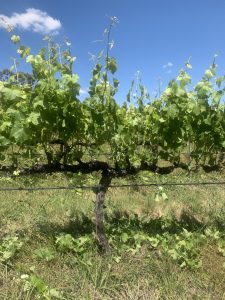
A wet winter followed by a wet spring, followed by a full moon, followed by a Currawong flying East at sunrise. It all leads to an over-vitalised soil and fungal organisms migrating northwards – into the grapevine canopy. Where they need not be. Disease pressure through early summer was high – higher than our conviction not to spray symptom chasing, band-aid like allelopathic substances. The probiotic approach – onwards and upwards. Whilst our aversion to the “organic” copper and sulphur treatments remained strong, we did concede amongst the onslaught of rain and fungal spores that spraying both pure Neem seed oil and EcoCarb (potassium bicab) may be of some help. We used both of these products with the intent on suppressing pathogenic organisms. Whilst no doubt these had an impact and were disease suppressive, I have even less doubt that these also harmed many beneficial microorganisms – which are crucial to overall vine health and wine quality. Two steps forward and one-and-a-half steps backwards.
 When confronted with excessive moisture in spring and early summer a few tools can be acquired from the faithful biodynamic toolbox. Monthly sprays of BD508 (Casuarina tea) preferably at Moon opposite Sun (Full moon for the uninitiated). A spraying of BD501 (Horn silica), possibly with the radical decision to spray alone and not with its natural bed mate BD500 (cow shit in a horn for the uninitiated). Apparently BD505 (aka oak bark stuff in the skull of a domesticated animal, preferably within a flow of water) helps hold any excessive vitality below the soil surface. We also applied our very own revolutionary creation – BDWormPoo. Made the previous year by stuffing cow hooves with worm castings (poo). The earth worm is the most magnificent regulator of soil vitality. Exactly what’s needed when things are a little too moist, there’s a full moon and a Currawong heading towards the horizon.
When confronted with excessive moisture in spring and early summer a few tools can be acquired from the faithful biodynamic toolbox. Monthly sprays of BD508 (Casuarina tea) preferably at Moon opposite Sun (Full moon for the uninitiated). A spraying of BD501 (Horn silica), possibly with the radical decision to spray alone and not with its natural bed mate BD500 (cow shit in a horn for the uninitiated). Apparently BD505 (aka oak bark stuff in the skull of a domesticated animal, preferably within a flow of water) helps hold any excessive vitality below the soil surface. We also applied our very own revolutionary creation – BDWormPoo. Made the previous year by stuffing cow hooves with worm castings (poo). The earth worm is the most magnificent regulator of soil vitality. Exactly what’s needed when things are a little too moist, there’s a full moon and a Currawong heading towards the horizon.
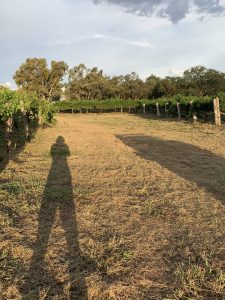 Analysing the sap from the young growing vine tissue revealed several nutrient deficiencies in the vine. Mostly micronutrients and a few of the more significant non-micro-ones. During the growing season the best way to address nutrient deficiencies is via the leaves. Spraying nutrients in the right form and at the right time onto the vine leaves is an extremely efficient and effective means to address a nutrient deficiency and boost plant immunity in the short-term. Long-term this strategy does not seem so viable. In some ways this seems like hacking the system – getting immediate responses in vine health and performance. On top of the highly technical and scientific sap analysis, we also regularly tracked vine health using a rather simple, yet still somewhat scientific tool which measures the degree to which light bends when passing through a fluid. A refractometer. Regularly measuring the total sugars in a plants sap can indicate the level of vine health. Akin to live statistic updates on a game of sports. Real. Live. Infield. Data.
Analysing the sap from the young growing vine tissue revealed several nutrient deficiencies in the vine. Mostly micronutrients and a few of the more significant non-micro-ones. During the growing season the best way to address nutrient deficiencies is via the leaves. Spraying nutrients in the right form and at the right time onto the vine leaves is an extremely efficient and effective means to address a nutrient deficiency and boost plant immunity in the short-term. Long-term this strategy does not seem so viable. In some ways this seems like hacking the system – getting immediate responses in vine health and performance. On top of the highly technical and scientific sap analysis, we also regularly tracked vine health using a rather simple, yet still somewhat scientific tool which measures the degree to which light bends when passing through a fluid. A refractometer. Regularly measuring the total sugars in a plants sap can indicate the level of vine health. Akin to live statistic updates on a game of sports. Real. Live. Infield. Data.
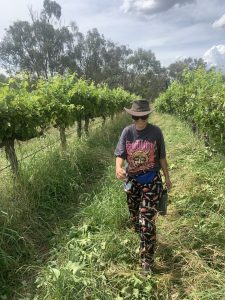 Weeds, cover crops, or the sun-ray energy converters. With excessive soil moisture comes wild under vine plant growth. Many grasses, forbs and a few legumes – mostly white clover – cover the ground. The weeds – as they have been called – were constantly threatening to outgrow their welcome and crowd out lower vine leaves. Something had to be done. Green means go. Go let your weeds grow wild, preferably for as long as possible. Green biomass means carbon. The more carbon cycling through the farm ecosystem the better the system will function. Both tillage and herbicide kill green plants whilst disturbing soil biology and structure. In lieu of properly managed livestock – the supreme ecosystem and soil carbon boosters – slashing and brush cutting under vine must suffice. Additions of biologically active compost tea and nutrients will aid in the breakdown of organic matter on the soil surface. The ever powerful biodynamic 500 prep, aka cow shit from a horn, simulates organic matter breakdown better than any of its peers.
Weeds, cover crops, or the sun-ray energy converters. With excessive soil moisture comes wild under vine plant growth. Many grasses, forbs and a few legumes – mostly white clover – cover the ground. The weeds – as they have been called – were constantly threatening to outgrow their welcome and crowd out lower vine leaves. Something had to be done. Green means go. Go let your weeds grow wild, preferably for as long as possible. Green biomass means carbon. The more carbon cycling through the farm ecosystem the better the system will function. Both tillage and herbicide kill green plants whilst disturbing soil biology and structure. In lieu of properly managed livestock – the supreme ecosystem and soil carbon boosters – slashing and brush cutting under vine must suffice. Additions of biologically active compost tea and nutrients will aid in the breakdown of organic matter on the soil surface. The ever powerful biodynamic 500 prep, aka cow shit from a horn, simulates organic matter breakdown better than any of its peers.
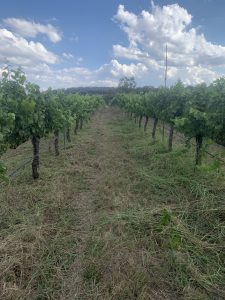 Like most things – timing is important. Slashing done at the right time, in time and of time, allows for maximum carbon to be drawn into the system. Ideally the period between slashing the under vine is significant enough to allow for full plant recovery. The goal is to have as much living root biomass in the ground for as long as reasonably possible. So we slashed and brush cut under the grape vines as little as possible (twice or thrice, depending on the area).
Like most things – timing is important. Slashing done at the right time, in time and of time, allows for maximum carbon to be drawn into the system. Ideally the period between slashing the under vine is significant enough to allow for full plant recovery. The goal is to have as much living root biomass in the ground for as long as reasonably possible. So we slashed and brush cut under the grape vines as little as possible (twice or thrice, depending on the area).
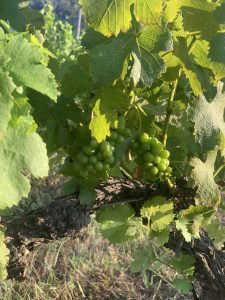 Mid-Summer stillness, critical moments of influence and a dance with the planets. The vines stretched themselves into mid-summer with dense green leaves, newly formed fruit clusters and a sigh of relief. The rain events had decreased in frequency and size, the sun was shining and fungal disease less ominous. Not to be confuse the apparent stillness around summer solstice with a decrease in workload, many vines needed some lateral shoot attention and a little leaf plucking around newly formed clusters, furthermore some sneaky suckers had re-emerged in the most vigorous varieties and disease pressure was hovering at the periphery. Carrying forward with the vines momentum we continued to spray out a general plant health tonic consisting of fish, seaweed and micronutrients – all organic of course.
Mid-Summer stillness, critical moments of influence and a dance with the planets. The vines stretched themselves into mid-summer with dense green leaves, newly formed fruit clusters and a sigh of relief. The rain events had decreased in frequency and size, the sun was shining and fungal disease less ominous. Not to be confuse the apparent stillness around summer solstice with a decrease in workload, many vines needed some lateral shoot attention and a little leaf plucking around newly formed clusters, furthermore some sneaky suckers had re-emerged in the most vigorous varieties and disease pressure was hovering at the periphery. Carrying forward with the vines momentum we continued to spray out a general plant health tonic consisting of fish, seaweed and micronutrients – all organic of course.
With flowering and fruit set underway our biodynamic applications have taken a very directed yet experimental approach. Three critical moments arise when you’re on the path of making wines in amongst the vines: flowering, fruit set/fill, and ripening. Three planets and three biodynamic preparations align with these three stages of grapevine reproduction. Namely: Valerian 507 & Mars & flowering, Dandelion 506 & Jupiter & fruit fill and Casuarina 508 & Saturn & ripening. Execution of the audacious cosmic plan came down to timing. Spraying out the biodynamic preparation at the critical point of grapevine development whilst the relevant planet is in opposition to the moon. Dancing with the planets. The end goal is optimising grapevine development at these important stages with the hope of maximising fruit quality at the end of the season.
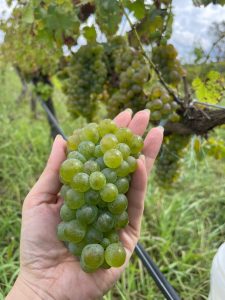 The slow descent into harvest and feasting on grapes. As the daylight starts to disappear before your eyes, the fruit on the vine is continuing to appear, gaining plumpness and colour with every day. Green, sharp and firm, slowly transitioning into sweet, subtle and soft. As summer turns towards autumn the workload in the vineyard starts to ease. A final biodynamic spray before harvest, a little fish and seaweed fertiliser to boost the vine across the line and installing our avian expulsion system (bird nets for the uniniated). Oh, and lots and lots of berry tasting. As summer started to wind down, a little downy mildew had crept into the vineyard – no sleep lost at this stage. Furthermore, and in defiance of conventional wisdom, no bunch rot or disease on the slowly ripening fruit!!! Who said you need chemicals to grow delicious, clean, fruit? Just some solid convictions, a little naivety and the beat of the cosmos. And some scientific analysis, organic nutrients and a bit of luck………
The slow descent into harvest and feasting on grapes. As the daylight starts to disappear before your eyes, the fruit on the vine is continuing to appear, gaining plumpness and colour with every day. Green, sharp and firm, slowly transitioning into sweet, subtle and soft. As summer turns towards autumn the workload in the vineyard starts to ease. A final biodynamic spray before harvest, a little fish and seaweed fertiliser to boost the vine across the line and installing our avian expulsion system (bird nets for the uniniated). Oh, and lots and lots of berry tasting. As summer started to wind down, a little downy mildew had crept into the vineyard – no sleep lost at this stage. Furthermore, and in defiance of conventional wisdom, no bunch rot or disease on the slowly ripening fruit!!! Who said you need chemicals to grow delicious, clean, fruit? Just some solid convictions, a little naivety and the beat of the cosmos. And some scientific analysis, organic nutrients and a bit of luck………
One of the most rewarding jobs of the vigneron occurs prior to harvest. Strolling up and down rows of vines, picking berries, sucking pulp, rubbing skins and crushing seeds. All in anticipation of what could be – several months of single- minded work reaching its climax in your mouth. Was that skin a little green? The seed not so crunchy? Acid dropping? Fruity flavour lingering? Length? Depth? Breadth? Wait, I think that berry was nearly ripe!!!!
 Climaxing, it’s a little wet, are we there yet? The climax of the growing season arrives when the grapes are determined to be ripe. Naturally. Grape berry ripeness means different things to different folks. A strict scientific analysis can inform you of the rising sugars and degrading acids. The preferred method of oral examination in the vineyard will indicate flavour density and physiological ripeness – texture and degree of greenness of tannins and other phenolics in skins and seeds. As we have no intention of adding to or manipulating the fruit once in the winery, we try and find a balancing point between flavour/acid balance, pH and phenolic ripeness. Let the sugars be what the sugars be. The ripening period this year was defined by relatively cool daytime temperatures – some very cold evenings – and patches of rain. The result was slowly increasing sugars and slowly degrading acids. The not-so-fast unfolding of time allowed us to wait until flavours filled the mouth, the greenness of the grapes was little more, all the while the acidity landed at the point of electrifying stability. Some intermittent rain events confused planned picking days as relating to the moon and its position relative to the starry background. But practicality must prevail. All-in-all nothing of concern.
Climaxing, it’s a little wet, are we there yet? The climax of the growing season arrives when the grapes are determined to be ripe. Naturally. Grape berry ripeness means different things to different folks. A strict scientific analysis can inform you of the rising sugars and degrading acids. The preferred method of oral examination in the vineyard will indicate flavour density and physiological ripeness – texture and degree of greenness of tannins and other phenolics in skins and seeds. As we have no intention of adding to or manipulating the fruit once in the winery, we try and find a balancing point between flavour/acid balance, pH and phenolic ripeness. Let the sugars be what the sugars be. The ripening period this year was defined by relatively cool daytime temperatures – some very cold evenings – and patches of rain. The result was slowly increasing sugars and slowly degrading acids. The not-so-fast unfolding of time allowed us to wait until flavours filled the mouth, the greenness of the grapes was little more, all the while the acidity landed at the point of electrifying stability. Some intermittent rain events confused planned picking days as relating to the moon and its position relative to the starry background. But practicality must prevail. All-in-all nothing of concern.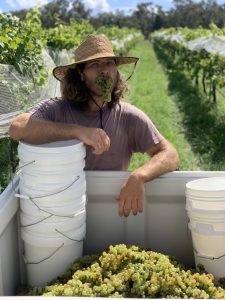
And thus with the picking of the grapes we arrive at our destination – the ferment shed.
A VIGNERON, A VINE AND THREE PLANETS WALK INTO A BAR… The Vigneron says to the Vine, “show me how you flower.”
If you are growing wine, there is one thing you prioritise above all else – that’s growing wine. The economics of wine growing,
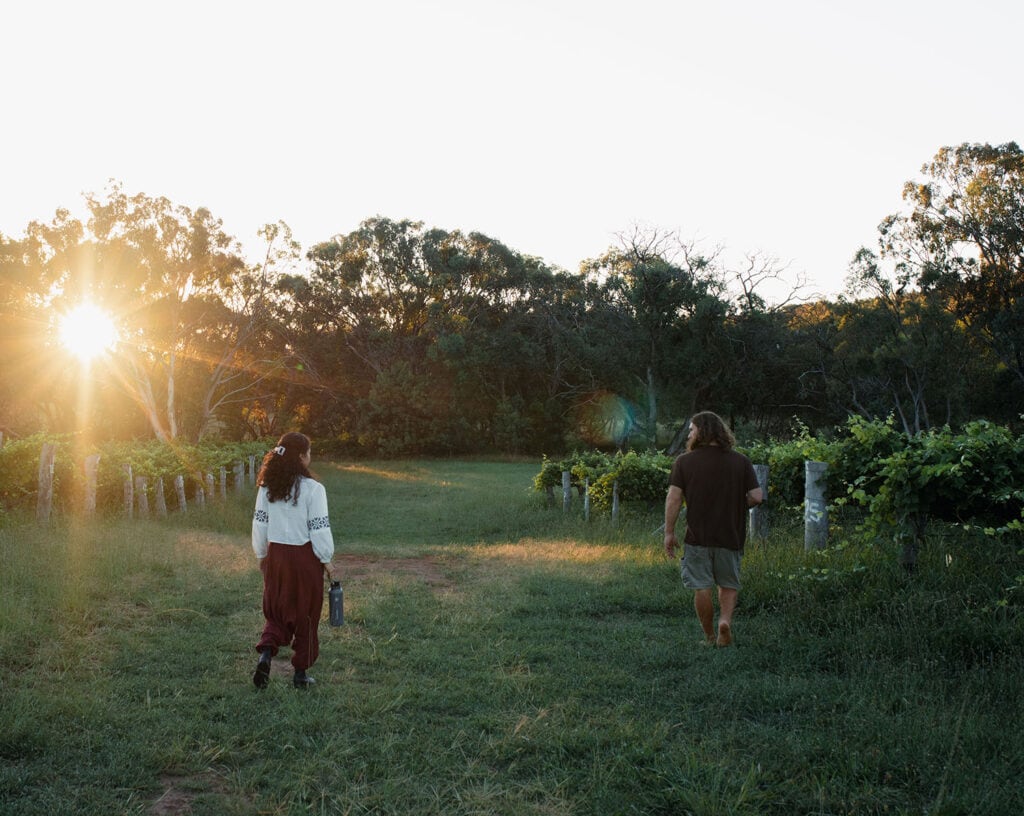

First generation farmers who believe that soil health & nutrition is not only important but also very cool. Our minimalist philosophy carries from our feet on the earth, through our hearts and to our vines.
Liquor license number: LIQW880010288
‘It is against the law to sell or supply alcohol to, or to obtain alcohol on behalf of, a person under the age of 18 years.’
We acknowledge the traditional custodians of this land – the Wiradjuri people – who have cared for and shaped this region since the beginning of time. We hope to pay our respects to their enduring custodianship through careful and considered land management.
Design & Development by AKIRE.Studio
Join our newsletter to be the first to hear about product drops, blog posts & adventures…